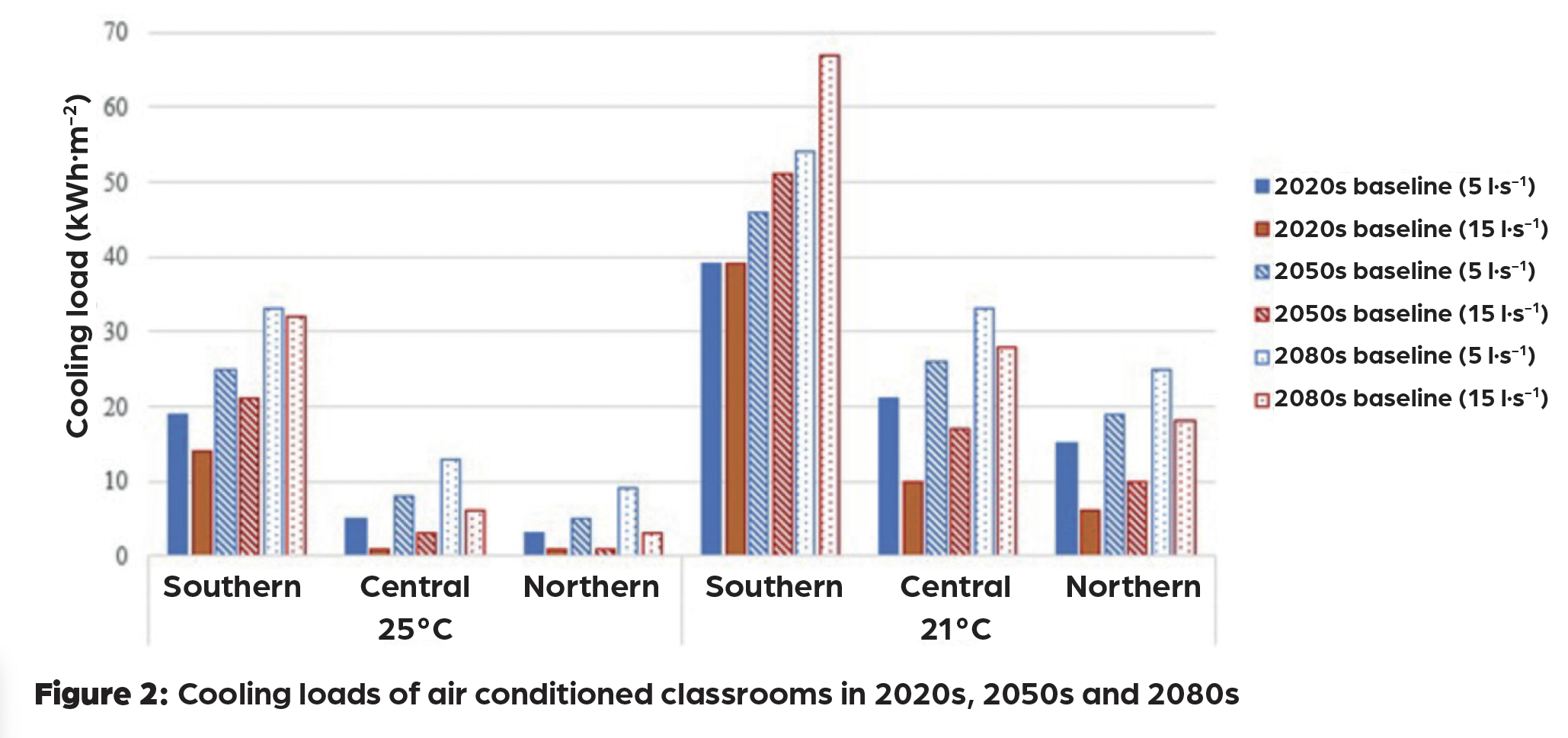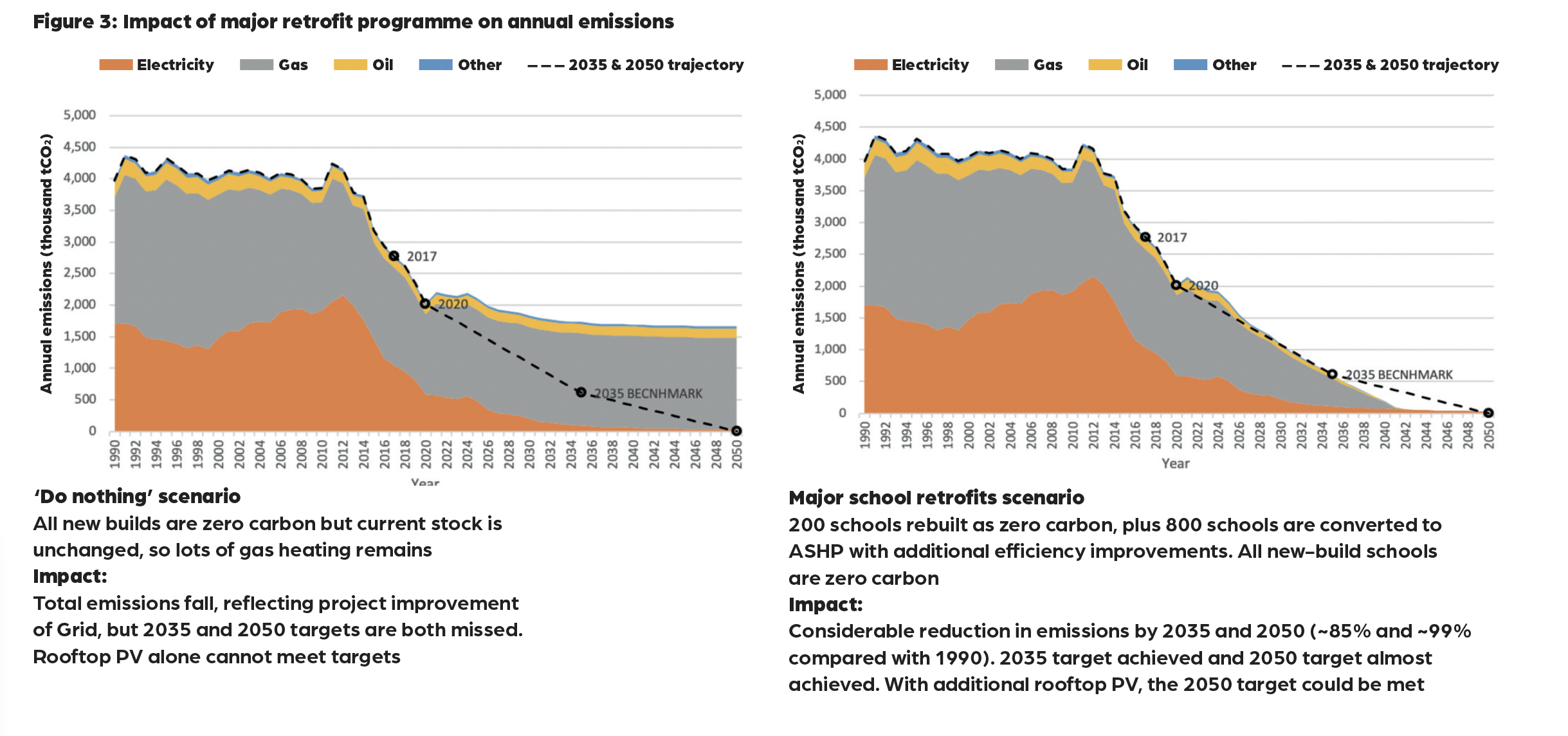
The decarbonisation of UK schools will be critical in achieving net zero carbon in public sector buildings by 2020. They contribute 24% of carbon emissions in the sector and are responsible for 2% of all UK emissions.
For new schools, the Department for Education (DfE) requires that 500 schools delivered under the School Building Programme by 2030 be net zero carbon in operation (bit.ly/CJSOS2J).
For existing schools, grants – such as the Public Sector Decarbonisation Scheme – are available for low carbon retrofits, but there is not yet a plan for wide-scale decarbonisation that would enable the school estate to meet 2050 net zero goals (bit.ly/CJSusDofE23).
Currently, only 30-50 primary and secondary schools a year are being retrofitted, but modelling by University College London (UCL) predicts that 800-1,000 schools per year will have to be retrofitted to meet 2050 targets.
The UK Parliament’s Environmental Audit Committee said the current pace of work to meet net zero lacks urgency (bit.ly/CJAOCsch23) and have called on the DfE to publish realistic and fully costed details of its sustainability plan. There is currently a £2bn annual shortfall in funding for repairing and maintaining the existing school estate, so investment in school decarbonisation will have to be carefully planned and justified.
To enable government to prioritise spending on decarbonisation, UCL has developed a dynamic thermal model that maps more than 67,000 buildings across 23,000 primary and secondary schools. The modelling platform is designed to simulate the performance of every building under a range of retrofit scenarios and, with the inclusion of CIBSE Weather Files, it can also assess the future risk of overheating.
The platform uses a range of data sources, including geospatial data, display energy certificates (DECs), and the ‘conditioning data collection’, a five-yearly survey of school buildings’ condition. There is also a plan to include embodied carbon data in the model.
The good news is that school performance has been improving (Figure 1), with a decrease in median energy use over the past 20 years of 35% for fossil fuel use. However, more technology in classrooms has seen electricity use rise by 39%.

As scientific adviser for climate change at the DfE, UCL’s Professor Dejan Mumovic FCIBSE is using the university’s model to underpin multiple research projects that the government is employing to develop its decarbonisation strategy. He says it is important that the net zero strategy for existing schools considers indoor environmental quality and children’s cognitive performance.
‘We have to ensure that the 10 million schoolchildren are in a safe indoor environment. We shouldn’t look at retrofits from a purely carbon emission perspective,’ says Mumovic, who will publish a paper on the topic this year. He adds that a holistic approach to retrofit will reap benefits for society, as school improvements will lead to healthier children.
This study on cognitive performance reveals that, because of climate change and overheating in classrooms, the percentage of cognitive performance loss of all schools in the south of England is modelled to increase from 51% to 72% in 2050, and 81% in 2080.
Schools as heat havens
The UCL model reveals that the risk of overheating is much more prevalent in southern regions of England, and to maintain comfortable temperatures in classrooms, the cooling load in the south will increase significantly
‘We are going to have a huge shift from heating to cooling load,’ explains Mumovic. ‘The cooling load in southern England will be 67 kWh.m-2 [to maintain temperatures at 21°C, assuming ventilation rate is 8 l·s-1], and if the ventilation rate is at the recommended 15 l·s-1, this will increase the load to 100kWh.m-2, which is the heating load for fossil fuel consumption in inefficient schools.’ (See Figure 2).

Future overheating incidents could be mitigated by when the building stock is used, says Mumovic, who adds: ‘They would be significantly reduced if you ended the summer term on 1 June.’
He also believes schools that are resilient to overheating could be used by the wider community. ‘They could act as a safe haven during heatwaves – they should be redefined as centres for communities. They are empty after 3pm, and then for half of the summer,’ he says.
Cooling delivered via heat pumps has the potential to be decarbonised via the Grid, but Mumovic warns against focusing solely on energy supply.
‘Replacing gas boilers with ASHP [air source heat pumps] is a bridging step, because we still need to focus on retrofitting to reduce energy demand in the long run,’ he says.
Decarbonisation strategy
The UCL model has the potential to offer a decarbonisation strategy for all schools, adds Mumovic: ‘Output from the model will allow you to compare different levels of retrofit – for example, minimal, medium and full decarbonisation. This would empower school leaders with the knowledge of their building’s performance and how it compares with peers.’
This level of information is worth £5-7,000 in consultant fees per school, says Mumovic, who suggests that schools in the lower 10th percentile of performance should be tackled first, with funding help from the government.
The CIBSE Energy Benchmarking Tool (bit.ly/CJEnBT) is a good place to start, he says, because it’s an easy way of comparing a school’s energy use according to DEC data. ‘It’s not enough to hit the target; it’s about maintaining it, so a monitoring policy must be established.’
A mechanism that incentivises stakeholders to commission schools properly is also needed, so performance matches design intent. There are examples of this in Scotland, where schools funded by the Scottish Futures Trust are awarded grants according to how well they perform after two years of operation (see page 30).
CIBSE has developed technical memorandums, TM61 and TM63, that help identify the causes of the energy performance gap, but they are not always used, says Mumovic, as project teams are afraid of what they might find.
What’s next?
Mumovic’s team has a project in the pipeline that looks at the long-term cost of poor environmental conditions1 and, later this year, CIBSE’s best practice TM57 Integrated school design, is due to be updated. With the UCL modelling platform and ongoing research, the foundation is being laid for a more sustainable, resilient future.
However, success will depend on coordinated action, adequate investment, and a commitment to maintaining performance beyond initial retrofits. Figure 3 shows such a scenario, where a major retrofit campaign results in net zero carbon schools by 2050.

References:
- P Hardelid and D Mumovic, ‘Realising the health co-benefits of transitioning to net zero carbon of UK building stock’, funded by UK Research and Innovation
Further reading
J Dong, Y Schwartz, I Korolija, D Mumovic. ‘Unintended consequences of English school stock energy-efficient retrofit on cognitive performance of children under climate change’, Building and Environment, Feb 2024, bit.ly/CJRetCog24
D Mumovic, D Chen and Z Zhao, ‘The combined impacts of indoor temperature and total volatile organic compounds on cognitive performance of university students: A controlled exposure study’, Science of the Total Environment, Feb 2025,
bit.ly/CJTempVOC


